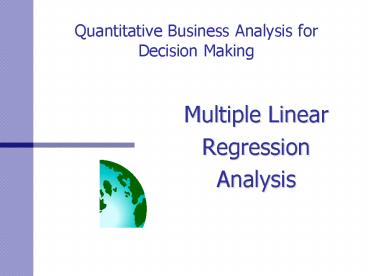Quantitative Business Analysis for Decision Making - PowerPoint PPT Presentation
1 / 13
Title:
Quantitative Business Analysis for Decision Making
Description:
Contributes to the variation in Y values from their mean , and ... For comparing with a reference ,test. statistic is: and for estimating by a confidence ... – PowerPoint PPT presentation
Number of Views:595
Avg rating:3.0/5.0
Title: Quantitative Business Analysis for Decision Making
1
Quantitative Business Analysis for Decision Making
- Multiple Linear
- Regression
- Analysis
2
Outlines
- Multiple Regression Model
- Estimation
- Testing Significance of Predictors
- Multicollinearity
- Selection of Predictors
- Diagnostic Plots
3
Multiple Regression Model
- Multiple linear regression model
- are slope coefficients of
- X1, X2 , ,Xk.
- quantifies the amount of change in
- response Y for a unit change in Xi when
- all other predictors are held fixed.
4
Multiple Regression Model (cont)
- In the model,
- is the mean of Y.
- Contributes to the variation in Y values from
their mean , and - is assumed normally distributed with mean 0
and standard deviation
5
Sampling
- A random sample of n units is taken. Then for
- each unit k1 measurements are made
- Y, X1 , X2 , ., Xk
6
Estimated Model
- Estimated multiple regression model is
- Expressions for bi are cumbersome to
- write. is an estimate of
7
Standard Error
Sample standard deviation around the mean
(estimated regression model) is It is an
estimate of Standard error of (for
specified values of predictors) is denoted by
8
Testing Significance of a Predictor
- For comparing with a reference ,test
- statistic is
- and for estimating by a confidence
- interval,
- compute
9
Coefficient of Determination
- Coefficient of determination R2 quantifies the
of - variation in the Y-distribution that is accounted
by the - predictors in the model. If
- R2 80, then 20 variation in the
Y-distribution is due to factors other than those
in the model. - R2 increases as predictors are added in the model
but at the cost of complicating it.
10
Testing the Model for Significance
- Null hypothesis predictors in the relationship
have no predictive power to explain the variation
in Y-distribution - Test statistic F . It
has - F- distribution with k and (n-k-1) degrees of
- freedoms for the numerator and denominator.
11
Multicollinearity and Selection of Predictors
- Multicollinearity - occurs when predictors are
highly - correlated among themselves. In its presence R2
may be high, - but individual coefficients are less reliable.
- Screening process (e.g. stepwise regression) can
eliminate - multicollinearity by selecting only those
predictors that are not - strongly correlated among themselves.
12
Diagnostic Plots
- Residuals are used to diagnose
the validity of the model assumptions. - A scatter plot of the residuals against the
predicted values can serve as a diagnostic tool. - A diagnostic plot can identify outliers, unequal
- variability, and need for transformation to
achieve - homogeneity etc.
13
Indicator Variables
- Indicator variables (also called dummy variables)
are - numerical codes that are used to represent
qualitative - variables.
- For example, 0 for men and 1 for women.
- For a qualitative variable with c categories,
(c-1) indicator variables need to be defined.































